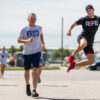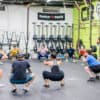I’ve written about heavy days before, but I think there should be come clarity because the difference between your plan of attack for a heavy back squat day versus how you should approach a heavy snatch day are very different with regard to reps and total volume.
If you are programming and don’t have a clear grasp of the effect that lifting heavy has on the CNS and what an appropriate route is to try to get an athlete to a PR, you could set them up for failure. For the core lifts i.e. squat, dead and press there is an optimal path to take before loading up the 1RM attempt. We like our athletes to get a good warm up in and get the heart rate up and get a sweat going before they touch the bar. Once we’ve established it’s time to get to the bar to start lifting the objective now becomes getting to the heaviest attempt in the least amount of lifts/poundage as possible. I’m not talking about loading up a max attempt with no prior sets (although I have seen people PR that way). I’ll break the numbers down and explain why in a bit. We want our athletes to hit the lighter weights (<50%) for doubles and triples to get the joints ready and the gross motor patterns down. We want light loads to get warm and get the CNS ready to go. Once we have established we are past the warm up sets and now working up in weight we like to do so in 4-5 lifts.
If you want to hit 400# it would look something like this:
Warm ups (no more than 5 reps) 135-225
Working up (doubles or maybe triples) 275-315-355- 380-400
Once we get above 80% nothing more than singles is necessary. (Remember this is not a training session this is a test day)
If the athlete gets too much volume in on the core lifts prior to the 1RM attempt the chances of hitting the PR drop drastically. The CNS can only take so much load on a given day.
Take away: For the basic lifts, get there quickly.
In order to demonstrate why this plan works for most athletes let’s look at some numbers and break them down lift by lift.
We are going to give a % for each lift based off of the heaviest load that can possibly be lifted. These are my actual numbers and they are far from impressive)
505# deadlift (100%)
420# back squat (83%)
355# front squat (70%)
305# clean (60%)
225# snatch (45%)- If I used my max snatch grip deadlift (~405#) its still only 55%
Now let’s think about comparing the core lifts and the Olympic lifts. A very simple way to distinguish between the two would be to categorize them as basic and complex. For the vast majority of us, the technical complexity is what makes the Olympic lifts so difficult. The increased ROM, the multiple pulling positions and mobility requirements are the limiting factors for the mortal population.
It isn’t uncommon to see athletes hit a PR during an EMOM. There is a reason for this that is very simple. EMOM’s are a great format to practice while learning to manage some degree of fatigue. We usually don’t practice the core lifts as frequently in this format because they are much easier to grasp from a speed, timing and positioning standpoint. The Olympic lifts are much more difficult to get a firm hold on. The reason athletes can hit PRs in an EMOM scenario is two fold
1) All the practice reps throughout the EMOM are how they iron out the wrinkles and make subtle corrections in route to that max effort lift.
2) Even maximal loads on the Olympic lifts are substantially lower than our overall max capacity.
The body can sustain much higher volume because the demand is lower on the CNS, but requires higher levels of coordination agility and speed.
Don’t believe me? Conduct a little experiment
Find something requires very fine motor skills. Something that is challenges your dexterity or something that requires a high level of hand eye coordination.
On day one choose either a heavy deadlift or heavy squat (go as heavy as possible) and test yourself before and after. You’ll be surprised how diminished your fine motor skills are immediately following those max efforts.
Do the same thing with a max clean and jerk or snatch. Note the difference in your before and after test.
Take away: Take your time on the Olympic lifts, get some volume under your belt and you and train the technique while getting the adaption you want.
Keep training hard and hit your weaknesses.
Fern





